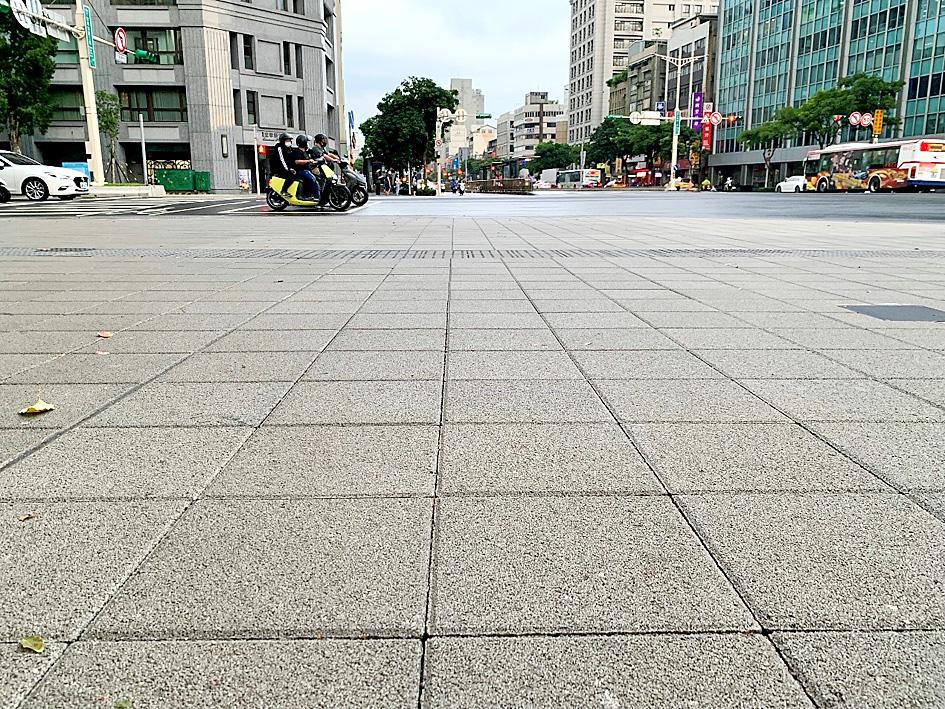Porous sidewalks installed in Taipei last year have been found to reduce surface temperatures by up to 3°C in addition to absorbing excessive runoff, researchers said on Thursday.
The Taipei City Government has been experimenting with new building materials since launching a “sponge city” initiative in 2015 to improve drainage and flood controls in the capital.
Seeking to reduce runoff along Zhongxiao E Road, which is prone to flooding, the city replaced its asphalt and concrete sidewalks with a more porous material.

Photo courtesy of National Taipei University of Technology
To test the effectiveness of the renovation completed late last year, researchers from the National Taipei University of Technology’s Water Environment Research Center installed a sensor in front of Zhongxiao Xinsheng MRT Station Exit 4 to monitor how much water was absorbed by the pavement.
They discovered that the material was not only effective at reducing runoff, but also had a lower temperature than other types of pavement.
Data gathered from March 9 to Aug. 31 showed that the sidewalk can reduce runoff by 13.8 to 63.4 percent, or about 40 percent on average, compared with traditional materials, the center said.
Its surface temperature was on average 2.5°C cooler than asphalt, center director Lin Jen-yang (林鎮洋) said.
The highest difference in temperature was recorded on July 26, when the porous surface was 3°C cooler than asphalt amid an atmospheric temperature of 37.4°C, Lin added.
The material can absorb more water because its porous structure allows runoff to seep into the ground instead of accumulating on top, he said.
In sunny weather, water evaporating from within the porous pavement helps cool down the surface and the air above it, he added.
“You can think of it like a sponge absorbing water,” Lin said. “The less runoff there is, the better the pavement is at absorbing rainwater.”
University president Wang Hsi-fu (王錫福) praised the renovation, saying that the wider sidewalks provide safer access to the school and complement the porous sidewalks installed on campus.
The university is the first school in the nation to use the more efficient pavement on a wide scale, directing the runoff to shallow decorative gullies surrounding the campus, Wang added.

Beijing could eventually see a full amphibious invasion of Taiwan as the only "prudent" way to bring about unification, the US Department of Defense said in a newly released annual report to Congress. The Pentagon's "Annual Report to Congress: Military and Security Developments Involving the People's Republic of China 2025," was in many ways similar to last year’s report but reorganized the analysis of the options China has to take over Taiwan. Generally, according to the report, Chinese leaders view the People's Liberation Army's (PLA) capabilities for a Taiwan campaign as improving, but they remain uncertain about its readiness to successfully seize

Taiwan is getting a day off on Christmas for the first time in 25 years. The change comes after opposition parties passed a law earlier this year to add or restore five public holidays, including Constitution Day, which falls on today, Dec. 25. The day marks the 1947 adoption of the constitution of the Republic of China, as the government in Taipei is formally known. Back then the Chinese Nationalist Party (KMT) governed China from Nanjing. When the KMT, now an opposition party in Taiwan, passed the legislation on holidays, it said that they would help “commemorate the history of national development.” That

Taiwan has overtaken South Korea this year in per capita income for the first time in 23 years, IMF data showed. Per capita income is a nation’s GDP divided by the total population, used to compare average wealth levels across countries. Taiwan also beat Japan this year on per capita income, after surpassing it for the first time last year, US magazine Newsweek reported yesterday. Across Asia, Taiwan ranked fourth for per capita income at US$37,827 this year due to sustained economic growth, the report said. In the top three spots were Singapore, Macau and Hong Kong, it said. South

HORROR STORIES: One victim recounted not realizing they had been stabbed and seeing people bleeding, while another recalled breaking down in tears after fleeing A man on Friday died after he tried to fight the knife-wielding suspect who went on a stabbing spree near two of Taipei’s busiest metro stations, Taipei Mayor Chiang Wan-an (蔣萬安) said. The 57-year-old man, identified by his family name, Yu (余), encountered the suspect at Exit M7 of Taipei Main Station and immediately tried to stop him, but was fatally wounded and later died, Chiang said, calling the incident “heartbreaking.” Yu’s family would receive at least NT$5 million (US$158,584) in compensation through the Taipei Rapid Transit Corp’s (TRTC) insurance coverage, he said after convening an emergency security response meeting yesterday morning. National